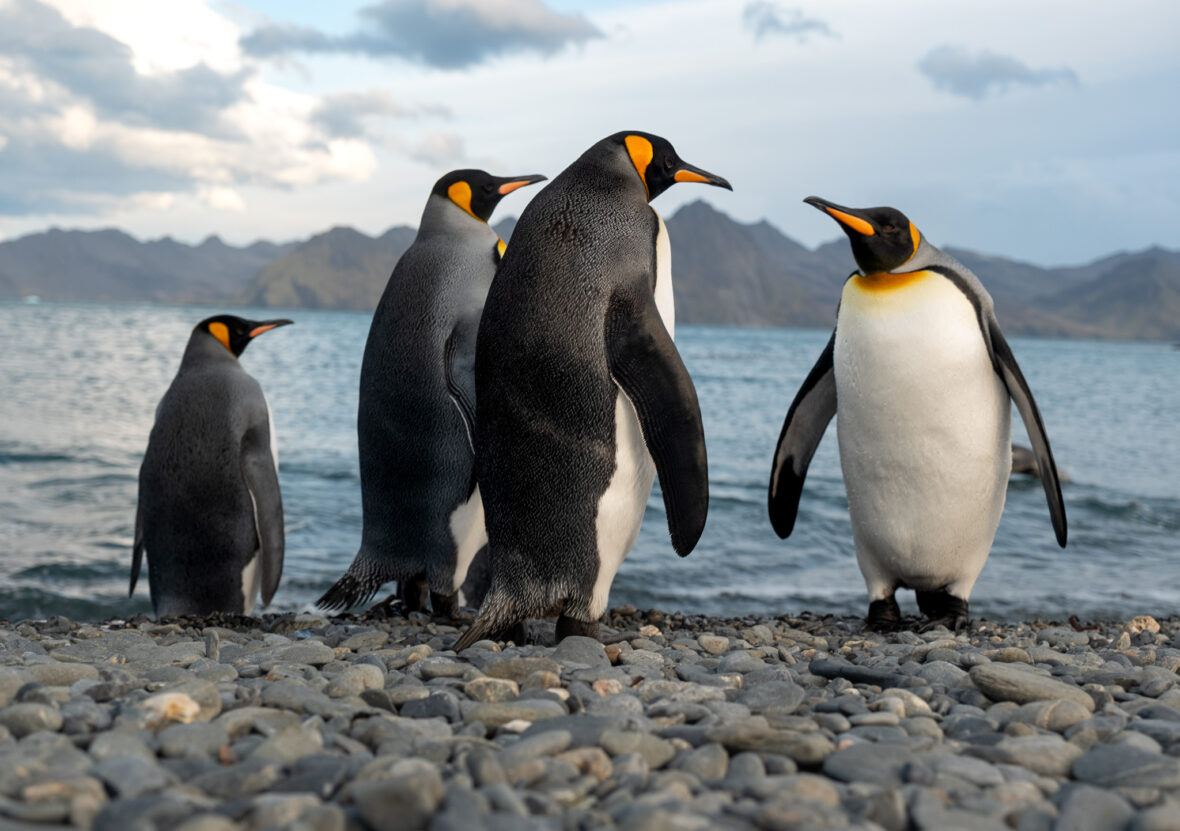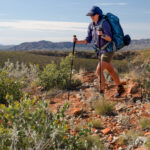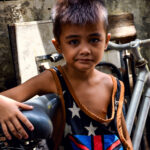A voyage to the Great White Continent calls for an expedition filled with adventure. Modern explorers lucky enough to visit this incredible land of ice and intrigue will find it at every turn.
From the comfort of a tiny portside restaurant in the southernmost town in the world, we wonder which of the three ships down at the pier is ours. None of them, it turns out. When it comes time to board, we discover ours hidden from view behind a much larger ship. It’s tiny by comparison, and looks a little like a tugboat a toddler might play with in the bath.
The Polar Pioneer isn’t fancy – it’s an old Russian research ship built for icy conditions – but that’s just what we were hoping for. We’re here for an expedition, not a cruise; we’re seeking an adventure that makes us feel like Antarctic explorers of yesteryear, not tourists on vacation.
Although the Polar Pioneer will be replaced later this year with a new 140-passenger expedition ship, (the Greg Mortimer, named after Aurora Expedition’s founder), the Australian company is aiming to give passengers the same down-to-earth Antarctic adventure they’ve been providing since Aurora’s launch 27 years ago.
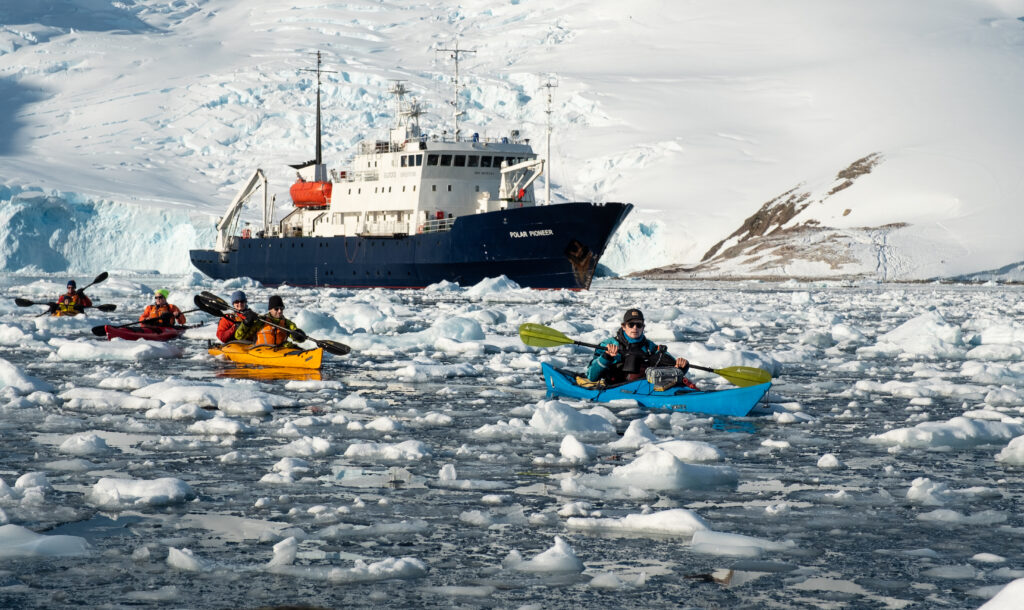
Titled ‘In Shackleton’s Footsteps’, our 18-day voyage is set to take us to the very places British polar explorer Sir Ernest Shackleton sailed, landed and trekked in his failed quest to cross the continent back in 1914.
There are 46 passengers on board, ranging from a family with three young children and retirees ticking a much-yearned-for destination off their travel bucket list – to us, a wildlife-loving father-daughter duo travelling to our seventh continent.
The roughshod port town of Ushuaia becomes a cluster of lights that fade to pinpoints as we head out to sea. By midnight we’ve made it to the Drake Passage and wake to rocking and rolling seas that make me glad I’ve packed seasick tablets. Mari Fleri, the ship’s doctor, makes her rounds before breakfast, checking on each of the passengers with anti-nausea remedies at the ready.
The sun glints off the snowy peaks and glossy white penguin chests as they strut this way and that, preen their dense feathers, and raise their heads to the sky to sing out loud in a melodic vibrato.
The ocean swell makes it a challenge to move around the ship, more than a few drinks find their way into passengers’ laps at the bar that night, and cutlery slides off the communal tables in the dining rooms if you’re not quick enough to grab it as we lurch one way or the other.
Taking a shower is an act of bravery. There’s a grab handle to hold on to, but you’re shunted this way and that, sometimes violently, and it strikes me that this is the most dangerous shower I’ve ever had. And who knew showers could even BE dangerous?
We’ve a day at sea so we vacuum our gear learn about the protocol that protects the flora and fauna that call this vast desert home. Aurora Expeditions is a member of the International Association of Antarctica Tour Operators (IAATO) dedicated to sustainable and responsible tourism.
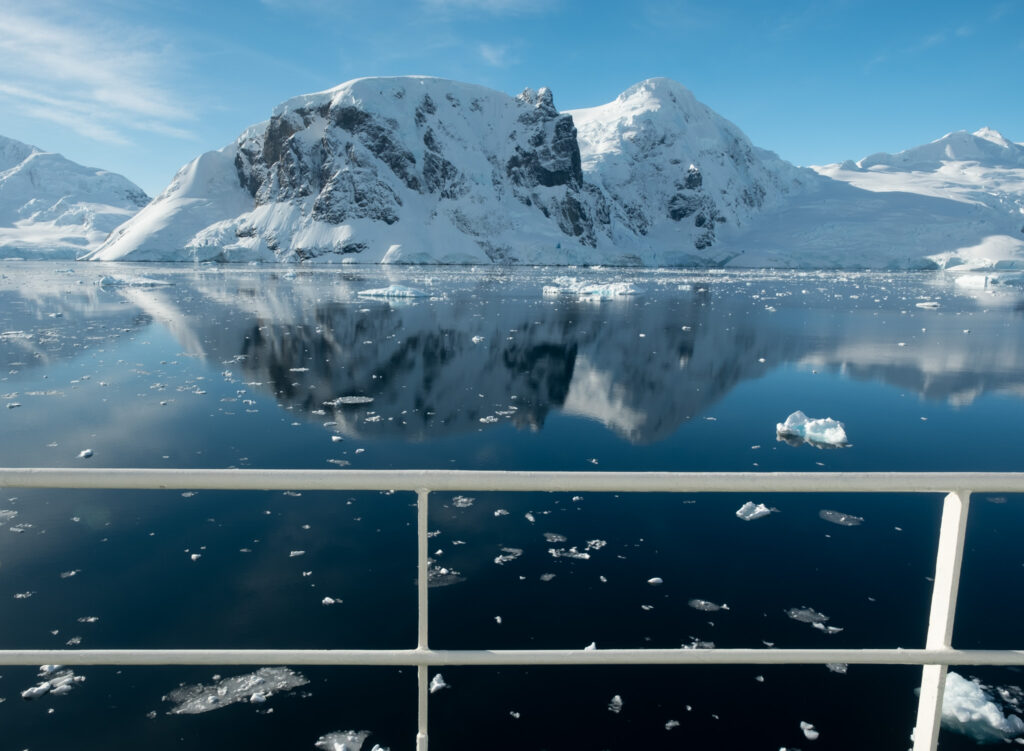
Explorers all
We enter the South Shetland Archipelago, a 540km stretch of 11 islands northwest of the Antarctic Peninsula. From the bridge, open to passengers for most of the trip, we spot our first iceberg – a 60-metre multifaceted towering monolith known as a ‘tabular berg’. But this spectacular sight is just the beginning of a trip that far exceeds all of our expectations.
I rise at dawn the next day to watch the sun rise over ice-covered land masses on both sides of the ship. We’ve arrived in Gerlache Strait, Antarctica, and the waters are blissfully calm. The sky glows pink, the moon shines bright, and the odd whale spouts and flips its tail above the surface of the water.
After breakfast it’s time to rug up in thermal layers, waterproof pants, gumboots and the warm Aurora Expeditions jacket each of us has been given. The day is icy cold and blue-sky beautiful when we board the zodiacs bound for a gentoo penguin rookery on Cuverville Island.
Hundreds of these comical little birds toddle about on the rocky shore, and you have to watch where you step lest you disturb one taking a nap. The breathtaking backdrop is all ice and mountains and reflections and icebergs; the pungent penguin-poo pong somehow at odds with the pristine surrounds.
The day is icy cold and blue-sky beautiful when we board the zodiacs bound for a gentoo penguin rookery on Cuverville Island.
Hours drift by as we watch and photograph and wander, mesmerised by penguins as curious about us as we are about them. No touching is allowed, and we’re advised not to go closer than five metres from them, but stand in one place for a few minutes and our fearless feathered friends come up to us.
Back on the zodiacs, we take our time heading back to the ship. A leopard seal toys with an unfortunate penguin destined to become lunch, two humpback whales blow and breach just a few metres from us, and groups of penguins zip past in search of krill to regurgitate for their young back on shore. It’s exhilarating just to be in this otherworldly land, and the wildlife is so close that it feels like I’m in the middle of a documentary.
The post-lunch scenery from the ship is stunning, and we spill out onto the decks to photograph the ice-laden sea, bergs and reflections drifting on by.
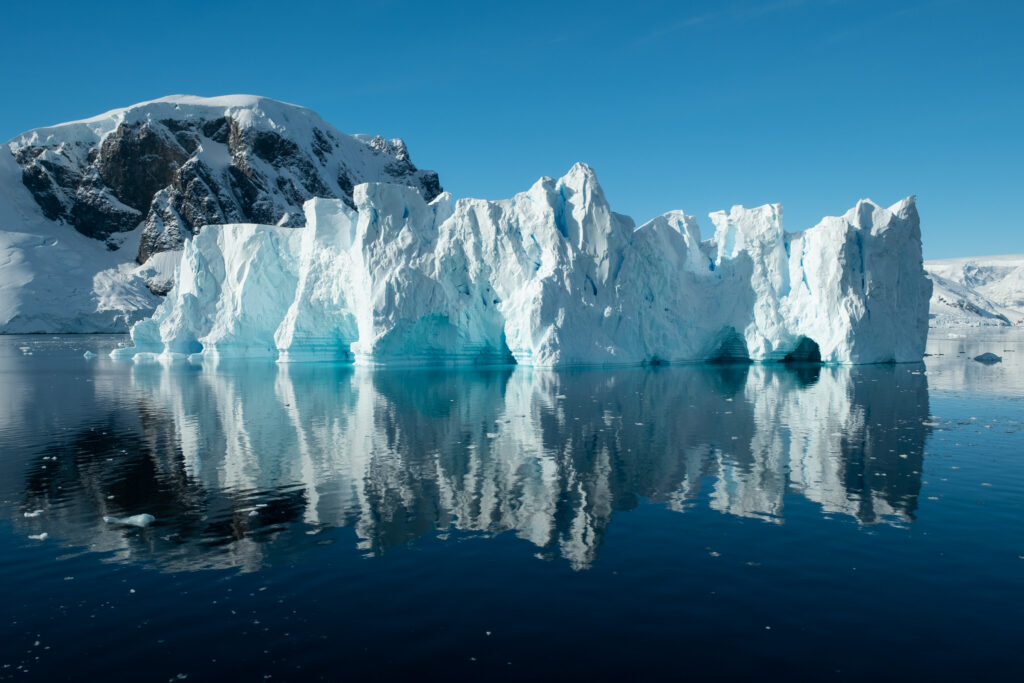
Before we know it we’re layering up and boarding the zodiacs again, this time bound for the mainland. We trek up a snowy hillside for a spectacular vista over the icy water and mountains beyond. A couple of penguins race past playing tag, one skidding onto its rounded belly to gather speed before easily finding its feet and racing off. Others bow their heads together in unison or play follow the leader. It’s mesmerising and meditative and we plop down in a patch of snow to take it all in. As days go, it doesn’t get much better than this.
The next day couldn’t be more different. The water has turned from glacier blue and mirror smooth to grey and choppy; it’s windy and the temperature has dropped to below zero. We rug up in extra layers to brave a zodiac outing, zipping around to see what we can see. Dr Gary Miller, our friendly expedition leader, shows us relics of the whaling industry (a rusted ship half submerged, old wooden whaling boats abandoned on snowy shores), his moustache turning walrus-like with ice as snow starts to swirl around us and the wind picks up. We spot two fur seals jostling for dominance, and soaring seabirds black against the cold, grey sky.
We hunch against the wind, enjoying every minute despite the conditions, and although reboarding the ship is a challenge, our seasoned guides and Russian seamen offer sturdy arms of support as we step from the bucking zodiac onto the gangway. We grin like mad through it all – it’s all part of the adventure.
On the days that follow, we’re reminded of just how unpredictable and perilous Antarctica can be. At Gourdin Island, impenetrable pack ice welded to the shoreline prevents us from landing. Even zipping over to take a look is tricky; brash ice has turned the water into a thick soup of ice chunks and slush.
Unexpectedly, a sleek leopard seal almost as long as our zodiac appears out of nowhere to play a game of ‘guess where I’m going to pop up next’ … when he starts having a little too much fun – bobbing up and biting the zodiacs – it’s time to make our escape.
Unexpectedly, a sleek leopard seal almost as long as our zodiac appears out of nowhere to play a game of ‘guess where I’m going to pop up next’ with us, sliding under and around zodiacs with a growing sense of delight. When he starts having a little too much fun – bobbing up and biting the zodiacs – it’s time to make our escape. An initial two puncture wounds grows to three when a slow leak is detected in the third zodiac later that day. Fortunately, they’re easily fixed.
The skies clear just in time for us to be deposited on the pebbled beach at Brown Bluff, the exposed portion of a glacial volcano. Steep cliffs rise steeply from the penguin-dotted beach, fur seals bask in the sunshine, and icebergs shine bright blue from the inside out against an emerald sea. At each of our landings (there are generally two a day), spreading out and having your own space to absorb the splendour at your pace is possible and one of the great pleasures of this voyage.
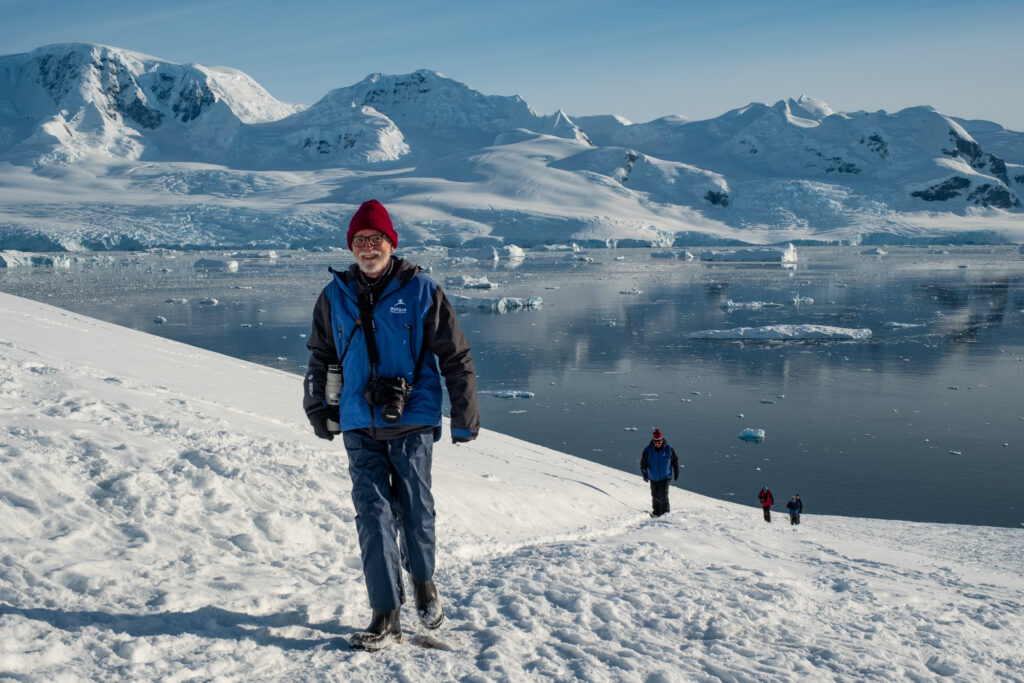
Land ho!
Two days at sea pass slowly despite the entertaining lectures on offer, and we’re morose with cabin fever by the time South Georgia island appears outside our porthole windows. Spirits rise with the announcement that we’re going to attempt a landing at Camp Cove. This narrow inlet was where Shackleton and his five crewmen landed with glee to get help for their men stranded on Elephant Island after fleeing their iced-in ship, the Endurance. They drank fresh water from the stream, feasted on roasted albatross, and found shelter in a shallow cave – heady stuff after weeks at sea in a tiny wooden boat.
Arriving unscathed and with boat in tact was no mean feat, as we were about to discover. Miller selected the most advanced zodiac drivers on board to navigate to shore and warned passengers that landing would be challenging. The swell was a little bigger than he anticipated on arrival at the mouth of the inlet, but he gave each zodiac driver the go ahead one by one to power in to shore in between wave sets. Adrenalin surging, life-jacketed passengers piled out into the wild water at shore with the crew on hand to assist. An unlucky few found themselves submerged in the icy water amid shouted instructions and hands reaching to haul them onto the seaweed-strewn shore.
“It was an adventure getting people to shore and we did get a few people wet but no one was hurt … the challenge is one reason why people come – they’re interested in going one step beyond their comfort zone.
“It was an adventure getting people to shore and we did get a few people wet but no one was hurt,” says Miller. “We timed it well and we were careful, but I think the challenge is one reason why people come – they’re interested in going one step beyond their comfort zone.”
Sydney molecular biologist Nicole Bryce says she joined Aurora’s expedition to Antarctica to experience a pristine part of the world untouched by mass tourism. “Parts of this trip have definitely been outside my comfort zone, and that’s a good thing.”
Bryce says the trip has also given her the luxury of time. “I’ve had the chance to step away from the constant stimulation of wifi and emails and personal demands and really enjoy nature; I’ve had the time to reflect and work out what’s really important to me.”
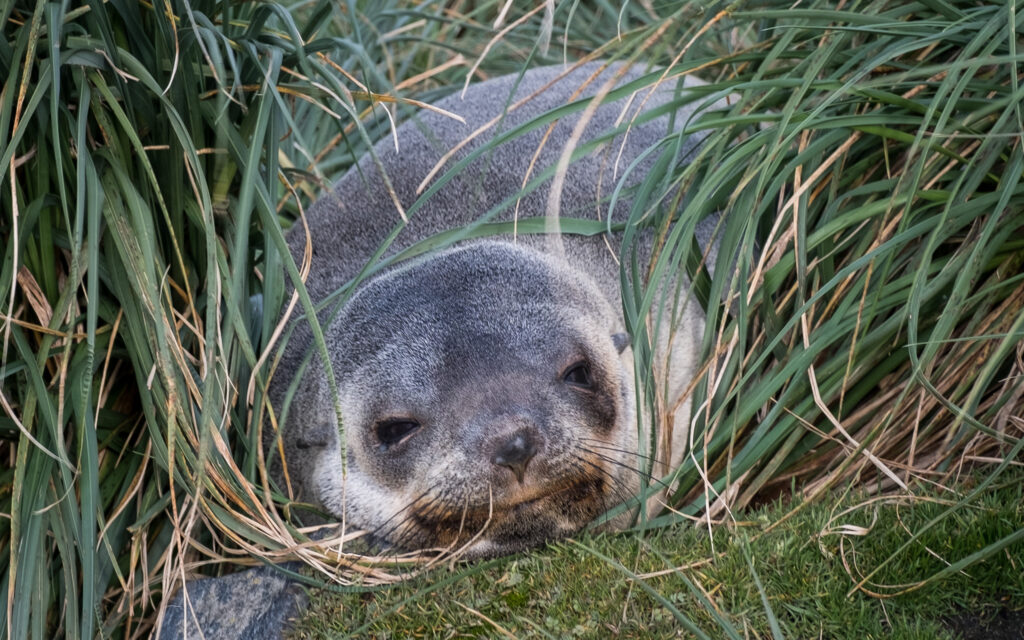
The adventure isn’t over once we all make it to the kelp-strewn shore. We come face to face with our first king penguin here, dodge growling fur seals that bluff charge you like cute but angry puppies, and give the great hulking slugs known as elephant seals a wide berth. These wallowing giants wear a look of pure contentment as they sleep squished up against one another in blubbery rows. Every now and then, two rear their heads and wrestle with teeth bared, before running out of steam and lying back down to recuperate.
We clamber up a steep hill, jumping from tussock to tussock to avoid the mud. Our reward is a glorious view of ice-capped mountains, icebergs bobbing up and down with the rise and fall of the glacial blue sea, and two albatross sitting on their nests just metres away.
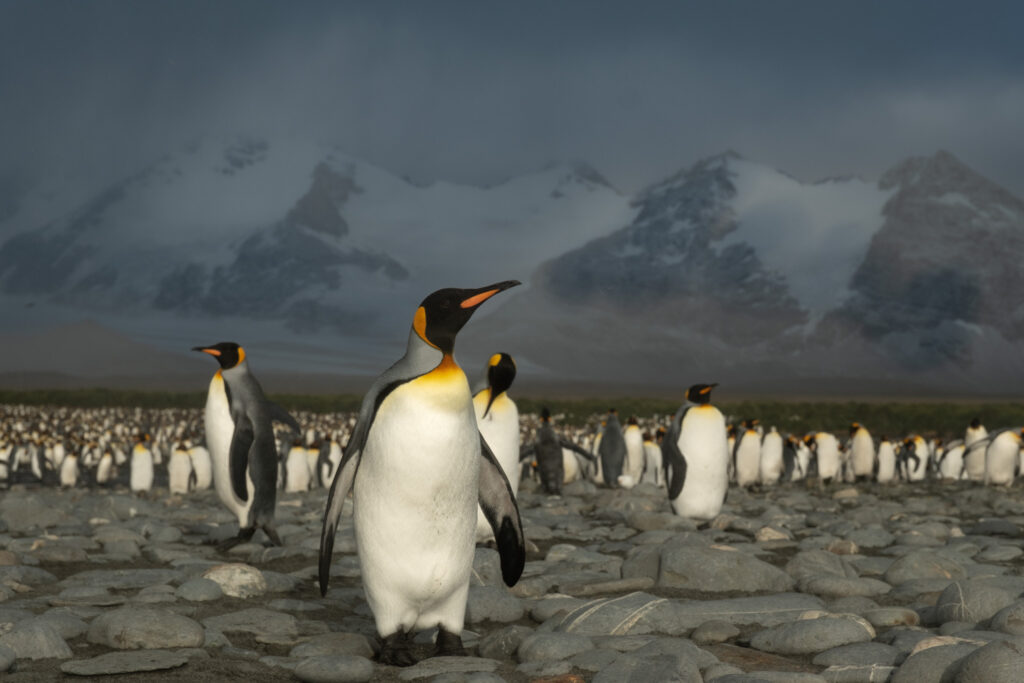
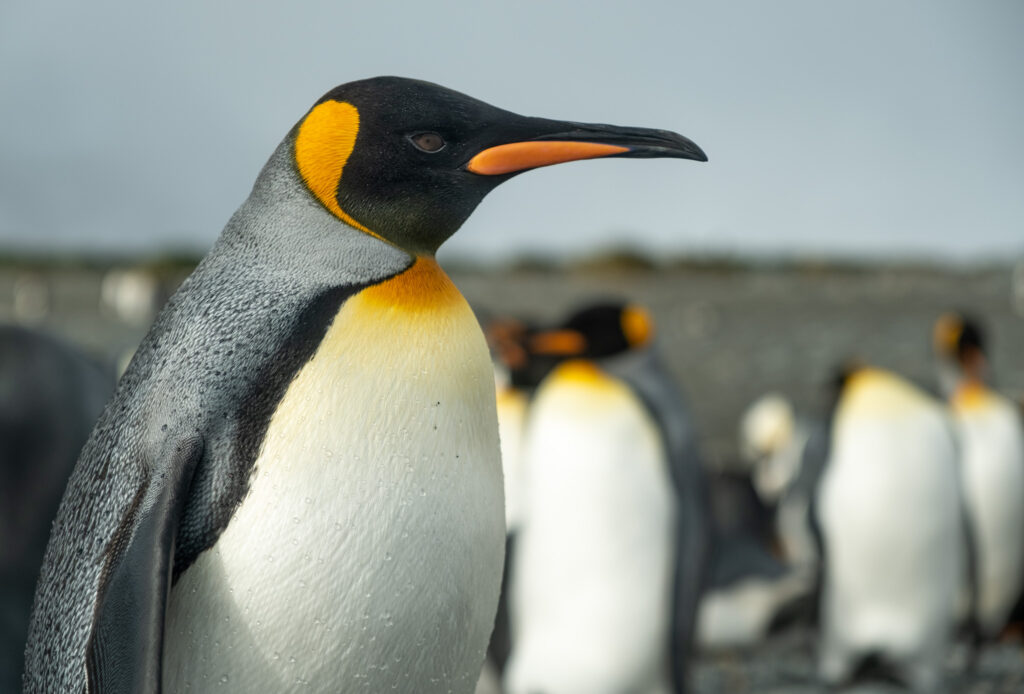
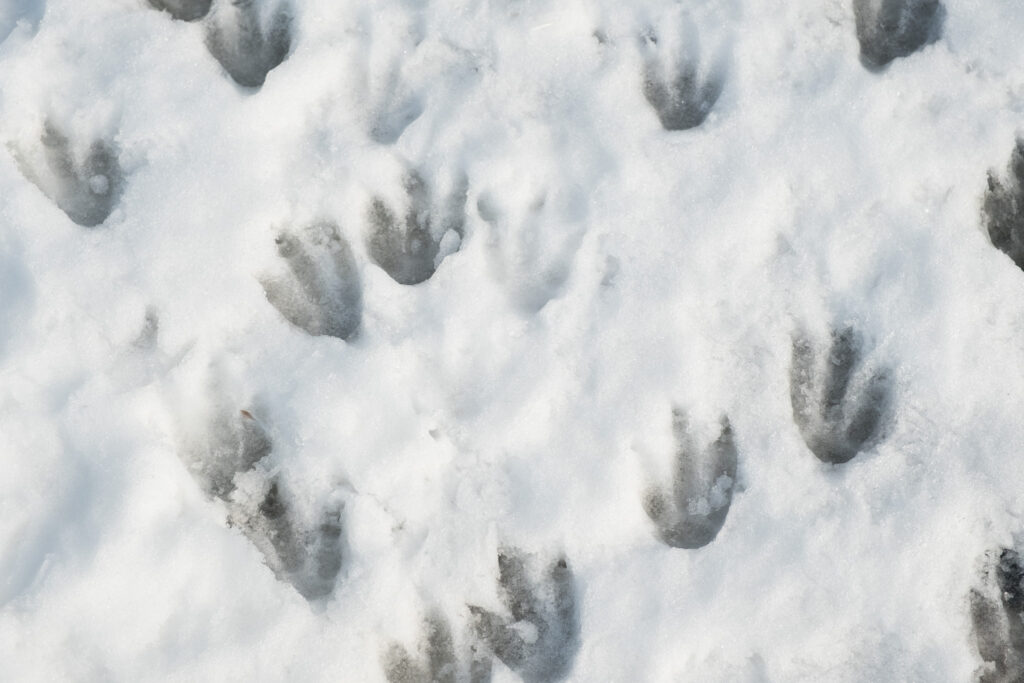
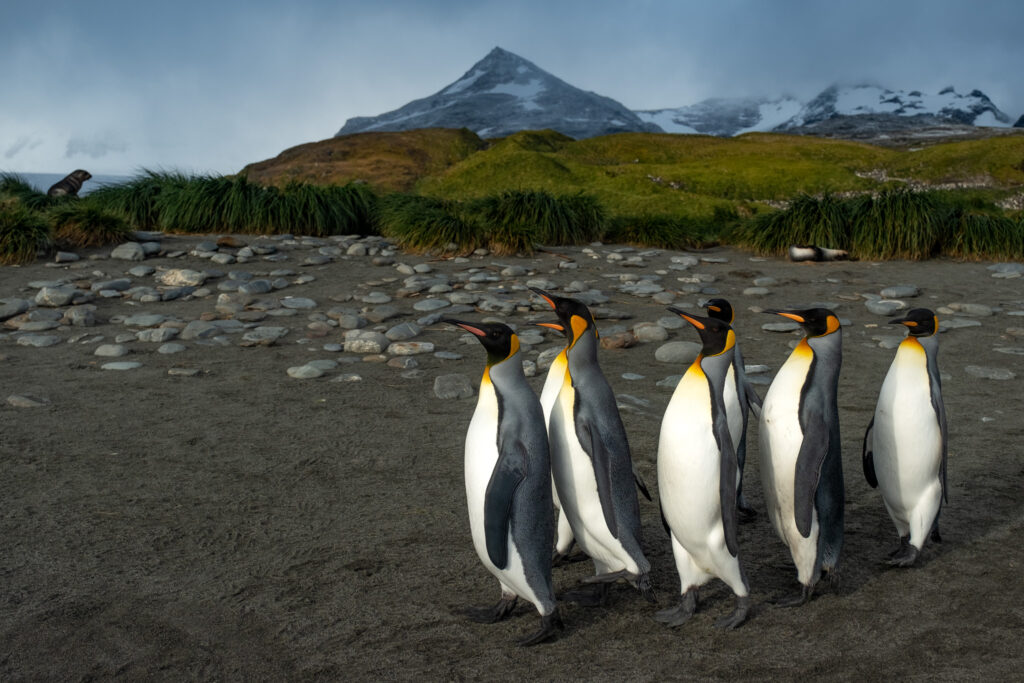
Although there’s a loose itinerary, weather and waves determine where and when we can make landings. Our plans to land at Gold Harbour are thwarted by gale force winds. The captain forges on in search of calmer waters and we find them at Royal Bay. Here, we commune with king penguins and watch young fur seals frolicking in and out of the water but by the time we head back to the ship, the winds have increased from 35 to 60 knots.
“Holy smokestacks!” says expedition guide Justin Febey, on seeing the waves crashing into the gangway, where we’re to climb aboard. Our Russian ‘gangway man’ somehow hauls each of us from the bucking zodiac while Feebs hangs on tight to the ropes tethering it to the ship. Hoisting the zodiacs on board becomes another feat for the crew, with assistant expedition leader Dr Robyn Mundy describing them as ‘one-tonne kites’ being tossed around by the ferocious winds.
We feel like true explorers now, and are hungry for more adventure, so when the ship motors around to Godthul and a ‘sunset cruise’ is offered, the presence of freezing temperatures, snow and stinging ice pellets isn’t going to stop us. Our reward is Lord of the Rings scenery and a stroll on a whale bone-strewn beach amongst the elephant seals. So worth it.
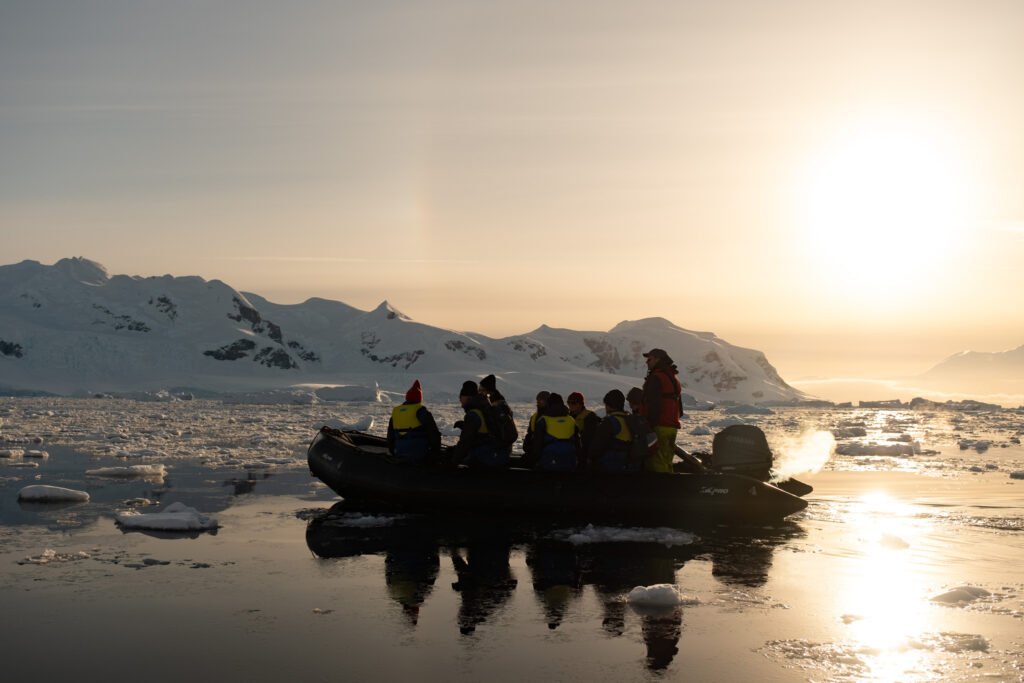
Whale of a time
Bio-security measures are tight on South Georgia. Having successfully eradicated rats, mice and deer, the goal is to allow native species to regenerate and to prevent introduced plants and animals coming off the passenger ships. We vacuum, wash and disinfect bags, clothing and boots before an inspector comes aboard to check.
Grytviken, a former whaling station turned research station, is both haunting and fascinating. We lean into the howling wind and sleet to walk from the cemetery where Shackleton is buried to a small museum, shop and post office – our first taste of civilisation off the ship since we left Argentina almost two weeks prior. Passing enormous rusted chains, sheds and water tanks around Jason Harbour, we battle the wind to climb up to a gusty headland where a memorial to Shackleton in the form of a cross stands proud.
Fur seals have rebounded with abundance in the decades since whaling ceased operations on South Georgia, and walking around the area means dodging bluff charging fur seals left and right. Despite the icy wind, the fur seals lie exposed to the elements as if sunbathing on a sunny summer’s day and loll about in the harbour shallows as if they’re enjoying a warm bath.
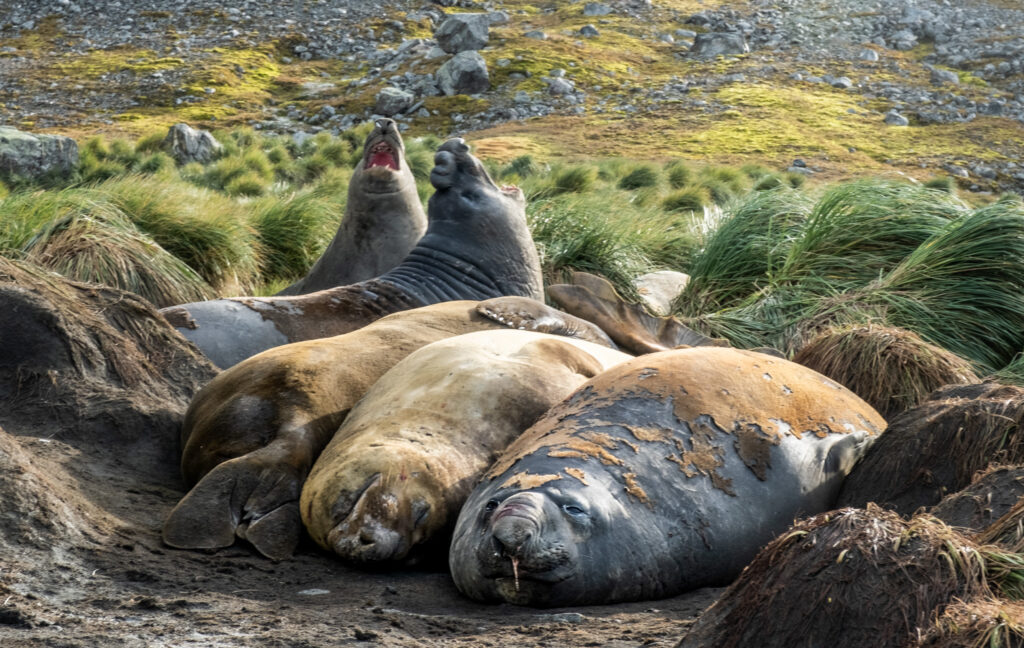
The day of big walk arrives before we know it, and we rise early to take advantage of the light. Once we land at Fortuna Bay the first stage of the walk – the same 6km walk Shackleton and his crew undertook in search of help for their stranded companions – I remark that it’s more mountain climbing than trekking. Up and up we went, 300 metres above the beach. And still higher, gumboots crunching into the scree as we climb. At the top, historian Alisdair McGregor reads from Shackleton’s account of this very walk, adding both context and atmosphere. It was in this very spot that he heard a steam whistle from a distant whaling station, signalling that help was at hand. “Never had any one of us heard sweeter music,” he wrote.
While Shackleton and his men ice picked their way down a frozen waterfall, we slip and shuffle our way down the steep and rocky hillside to the bottom – more than a few people losing their footing and sliding 10 metres or more in an involuntary shortcut. Stromness Bay and its now derelict whaling station visible in the distance, we walk the last few kilometres with snow-capped mountains at our backs and a symphony of seal growls, hoots, bleats and cackles all around. The three-hour walk gave us a taste of the challenges Shackleton faced on his now-famous odyssey.
Los Angeles retiree Terry Andrues, 67, had been wanting to visit Antarctica since primary school, when he learned about Shackleton’s exploits. “I finally got the chance to come and see the places he’d been,” he says. Andrues says he appreciates the beauty of nature like never before, that the wildlife has been spectacular. “It’s made me realise there is so much unseen grandeur in the world.”
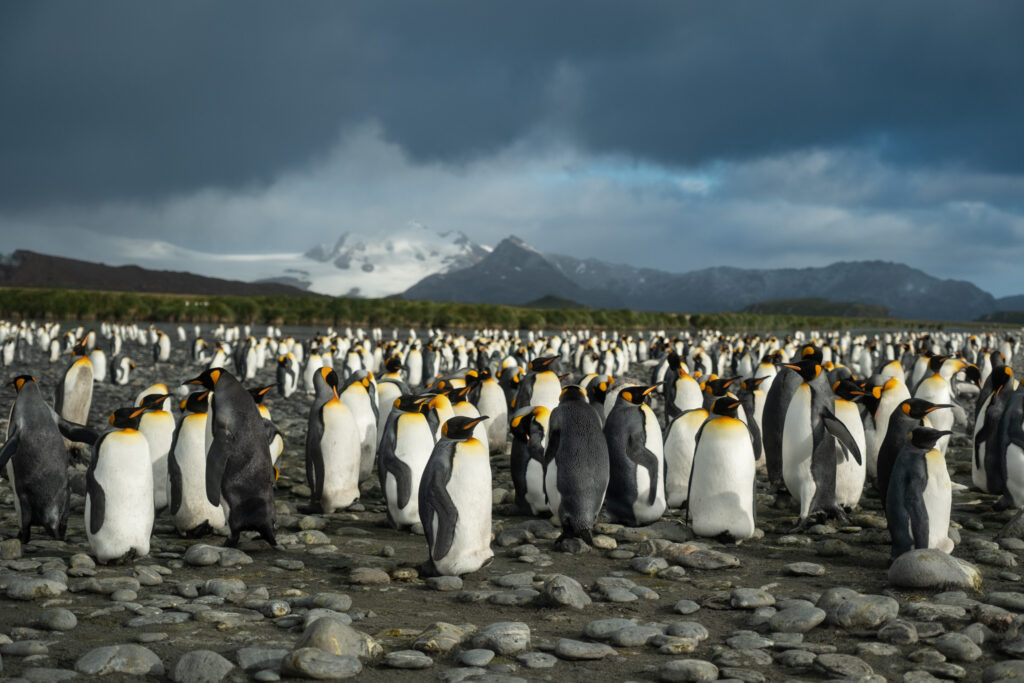
As far as grand finales go, our last day tops them all. The day dawns sunny and bright and when we land at Salisbury Plain, we find no fewer than 120,000 king penguins stretching from the beach, across the muddy plain, and up the grassy hillside. The air is thick with penguin-poo pong, the sound is deafening, and the sight is unforgettable.
I trudge through sludge and mud in an effort to reach higher grand, but when my travelling companion sinks thigh deep into a muddy quagmire and can’t get out without the hauling power of Scott Portelli, Aurora’s guest photographer, we rethink our mission and head back to the throngs of penguins closer to shore.
The sun glints off the snowy peaks and glossy white penguin chests as they strut this way and that, preen their dense feathers, and raise their heads to the sky to sing out loud in a melodic vibrato.
Dotted throughout the massive colony are fluffy brown chicks who look nothing like their majestic parents but are adorable nonetheless. Some penguins balance eggs on their feet, keeping them warm with a fold of feathers, others march in rows down to the water where they turn from awkward waddlers to streaks of light zipping through the water. The young fur seals, meanwhile, race up and down the shoreline leaping in and out of the water in playful delight. Like us on this fine day, they haven’t a care in the world.
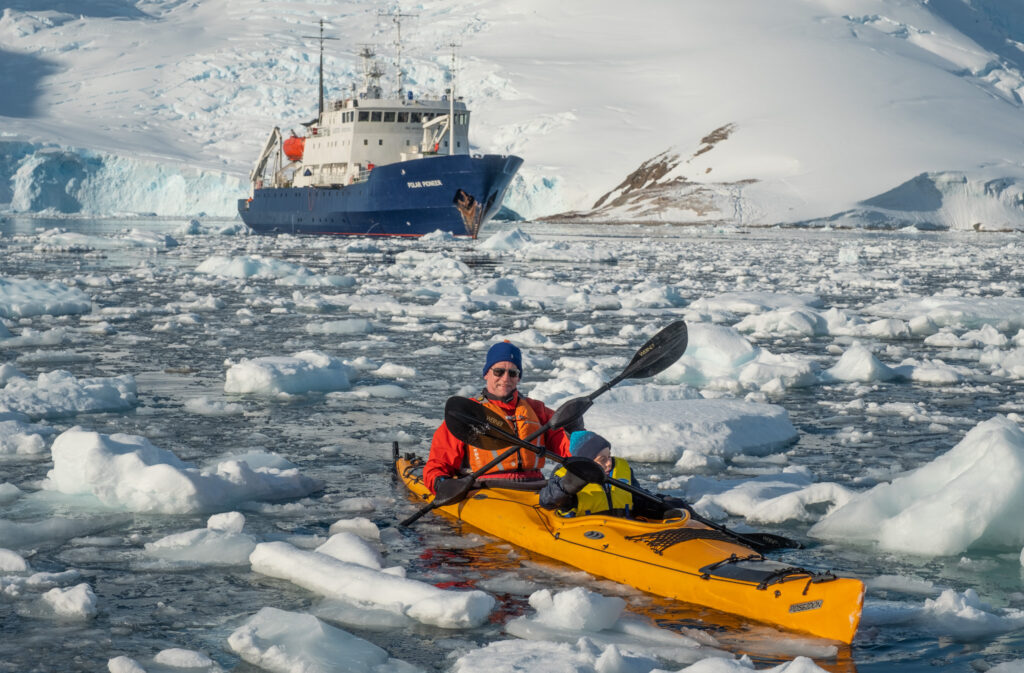
TRAVEL FILE
LATAM flies from Sydney and Melbourne direct to Santiago, where there are interconnecting flights to Ushuaia via Buenos Aires.
Aurora Expeditions specialises in off-the-beaten-track destinations around the world on small ships with expert guides. Environmentally responsible, Aurora has been taking travellers of all ages to Antarctica for 25 years. The Australian company takes care of flights, accommodation, tours and transfers, and offers optional extras such as camping, kayaking and snow shoeing. Antarctic expeditions depart between November and March.
This article first appeared in MiNDFOOD magazine.

